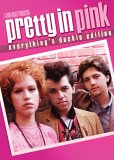| Reviews & Columns |
|
Reviews DVD TV on DVD Blu-ray 4K UHD International DVDs In Theaters Reviews by Studio Video Games Features Collector Series DVDs Easter Egg Database Interviews DVD Talk Radio Feature Articles Columns Anime Talk DVD Savant Horror DVDs The M.O.D. Squad Art House HD Talk Silent DVD
|
DVD Talk Forum |
|
|
| Resources |
|
DVD Price Search Customer Service #'s RCE Info Links |
|
Columns
|
|
|
Pretty in Pink: Everything's Duckie Edition
THE MOVIE:
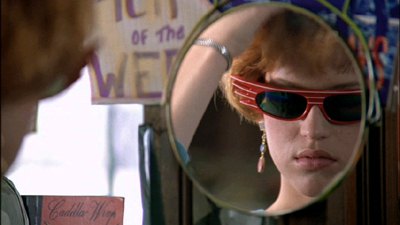
God, has it really been 20 years since Pretty in Pink came out? I guess it says something about what John Hughes captured on the subject of the teenage experience that his movies are held up as high examples of the genre to this day.
Paramount is commemorating this anniversary with the release of Pretty in Pink: Everything's Duckie Edition. While the film has been available on DVD previously, this is a double-dip worth the return to the punchbowl. The 2002 disc was the definition of bare bones, and while the video transfer and sound mix appear to be essentially the same, there is a lot of new programming on the Everything's Duckie Edition so PiP fans can finally go back to the prom in style.
But first, the movie...
Pretty in Pink is one of John Hughes' most simplistic plots. It stars his regular muse, Molly Ringwald, as Andie, the creative girl who is misunderstood by most of her peers at her economically unbalanced high school. She lives with her father (Harry Dean Stanton), a layabout who refuses to move past the fact his wife left him four years prior. Her best friend is Duckie (Jon Cryer), the cool nerd who adores her. Andie is oblivious to his affections, however, choosing instead to pine for the "richie" with the blank stare, Blane (Andrew McCarthy). Blane likes her, too, but will he have the backbone to defy his well-to-do buddies and take Andie to the prom? It's doubtful. He's no Jake Ryan, and as Duckie reminds us, Blane is a major appliance, it's not a name.
As hackneyed as that plot is on paper, Pretty in Pink really stands up as a well-crafted teenage romance. For all the kiddie schlock Hughes has pumped out in the last fifteen years, it's sometimes hard to remember how good he was with characters back in the day. Everyone here is incredibly well-drawn. Andie stays true to herself, sometimes to a fault, and Duckie is hysterically loveable. Even Blane is believably conflicted. Andrew McCarthy is way out of vogue now, but once upon a time, he excelled at playing this sort of white-bread character, the ones who mean well but have nothing to back up their intentions. The story is rounded out by an excellent supporting cast. Harry Dean Stanton should be everyone's dad. Even with his emotional problems, his rapport with Ringwald is sweet and touching. Annie Potts has a gas playing Ringwald's boss, Iona, the owner of the cool record store where Andie works, and a lot of us will remember Pretty in Pink as the first time we got to see James Spader play an evil slimeball with his trademark panache.
In addition to the love story, Pretty in Pink has social elements that have remained relevant even two decades later. Andie and Duckie are part of the Zoids, the natural opposites to the Richies (think the Greasers and the Socs in The Outsiders, and it adds proof to the timeless nature of the conflict), and bringing Andie and Blane together requires crossing that economic line, a modern-day Romeo and Juliet separated by bank accounts rather than family rivalry. Hughes and first-time director Howard Deutch handle this theme delicately, not making it too heavy handed, allowing them to bring it back around so that money stops being an issue. It's down to the personalities of the people, their moral compass. Once you look past the numbers in someone's checkbook, it's really a question of whether or not they're a jerk. The art department has some fun playing up these elements in subtle ways. Iona has a poster for The Misfits in her apartment, and even the record store's name, Trax, could arguably be seen to have some symbolic significance. Andie is on the wrong side of the Trax: she's standing behind the counter, whereas Blane will probably never work a day in his life.
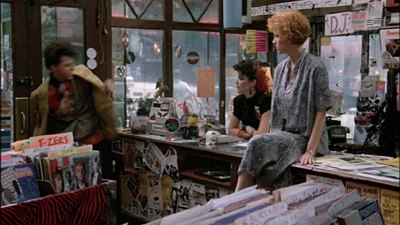
In fact, now that I've seen Pretty in Pink a million times, I've really started to notice the art direction more and more. The misfit crew has an incredible wardrobe. The more costume changes Andie, Duckie, and Iona make, the better! And the music geeks among us will have a blast picking out all the cool product used to decorate Trax. It may even be a cooler record store than Championship Vinyl in High Fidelity. (And speaking of cooler than High Fidelity, I'm sorry, but Jon Cryer lip-synching through Otis Redding's "Try A Little Tenderness" in Pretty in Pink ranks all over Jack Black's Marvin Gaye impersonation in High Fidelity). Beyond that, Hughes had an instinctual ear for soundtracks, and Pretty in Pink is probably his best, showcasing tracks from New Order, Echo and the Bunnymen, and Orchestral Manoeuvres in the Dark. Duckie sitting alone in his barren bedroom listening to the Smiths perform "Please Please Please Let Me Get What I Want" is the truest thirty seconds of teenage angst in any movie ever. As a time capsule of the '80s, Pretty in Pink makes the decade look and sound shockingly cool.
Notice how many times I've mentioned Duckie in the above? There is a reason that this DVD is the Everything's Duckie Edition. Everyone loves Duckie, and it's all down to Cryer's bravura performance. He makes Duckie that incredibly clever kid that could never fit, but who carries on being himself regardless. The love he feels for Andie is so true, it's hard not to swoon. There is a scene in Andie's bedroom where he can't restrain himself, and he falls back on her bed and declares his feelings to the ceiling. Anyone who has ever had a schoolyard crush knows how strong they could be, and also how much Duckie is hurting when Andie goes with Blane. Pretty in Pink is infamous for its ending, where Andie gets her storybook romance with Prince Charming (as Iona calls Blane), and Duckie gets...well, not nothing, he gets tossed the bone of a young Kristy Swanson before she became a freaky homewrecker. Originally, things were going to swing the other way, but audiences apparently reacted poorly in test screenings, so the ending was reshot. (You're not alone, Duckie. Ben Stiller also suffered this indignity in Reality Bites, and he was the damn director!) This issue is addressed at long last on this DVD, and for more on that, keep reading....
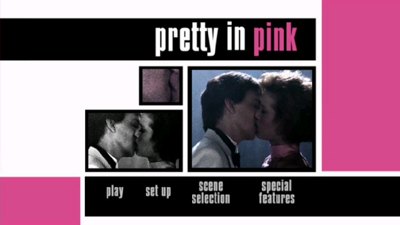
THE DVD
Video:
Both editions of Pretty in Pink have had widescreen transfers. While I doubt the studio went back and redid the transfer for the Everything's Duckie Edition (all the chapter stops are exactly the same), putting the disc on two machines and switching back and forth as they played, I did notice some subtle differences. The older DVD appeared to be more saturated in color, particularly hot colors like red and orange. Everything's Duckie was softer, more natural. It's a fine line, and a little hard to show in exact detail, but I tried for a couple of screen captures that might show the difference (though, it's more clear on my television). The first two show extreme close-ups on Molly Ringwald in the opening montage.
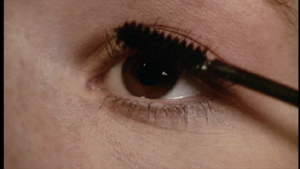
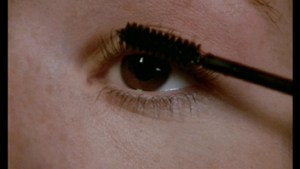
2002 Edition vs. 2006 Edition
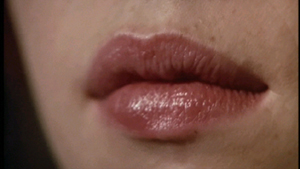
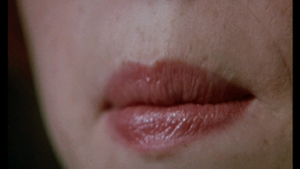
2002 Edition vs. 2006 Edition
To my eye, the newer picture captures a more realistic skin tone, whereas the 2002 disc has a little too much color.
The other test is a scene in darkness, with Duckie sitting outside the record store in the rain.
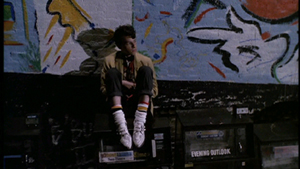
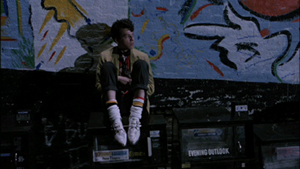
2002 Edition vs. 2006 Edition
Here, I am not sure which one I prefer. His clothes pop a lot more in 2002, but the 2006 DVD is moodier, darker. Again, it's probably more natural. This isn't a light comedy, the colors don't have to be ultra bright.
I doubt you'd even notice the difference if you weren't looking for it, to be honest. I weigh in on the Everything's Duckie Edition being an improvement, but it could just be a personal taste thing of where I choose to split the hairs.
Sound:
Viewers are given the option of both a 5.1 and 2.0 surround mix. Pretty in Pink: Everything's Duckie Edition gets a perfect score in the sound department. There are no weak spots. Plus, given how great the music is, we really want to hear the songs come through. New Order's "Elegia" has rarely sounded better.
Extras:
The sticker on the cardboard slipcover for Pretty in Pink: Everything's Duckie Edition promises that it's "Totally Packed with Special Features." For once, the marketing weasels are not lying. The extras aren't necessarily innovative as special features go, but there are eight documentaries that run for over an hour and a half. Really, it should have been one long documentary with chapters, but instead the studio has chosen to break them up into eight features, including one with a further submenu. The pieces are arranged in a natural running order, and all were made together, so it feels like one program. Points off for no "play all" function, but I do appreciate that when one feature ended and the menu came back up, the cursor was cued up on the next segment.
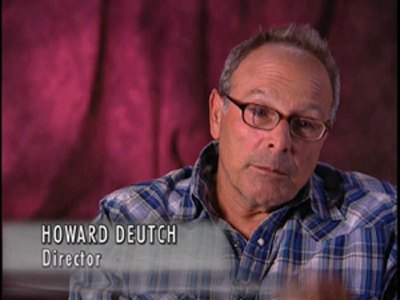
The documentaries are as follows:
* The First Time: The Making of Pretty in Pink: This is your basic introduction to the movie and to the style the behind-the-scenes features will take, mixing archival interviews with new ones. Participating in the contemporary interviews are director Howard Deutch, producer Lauren Shuler, and stars Molly Ringwald, John Cryer, Annie Potts, and Andrew McCarthy. (John Hughes is notable for his absence.) Deutch is particularly interesting in this segment, because in describing the involvement of the various backstage players, he's quite forthcoming in his admission of his own mistakes, like not trusting Hughes when it came to the soundtrack or his director of photography when lighting the big kiss scene. He was wrong both times, and he sees that now. (12 minutes)
* Zoids and Richies: This is a breakdown of the casting process, covering all the principle actors. Of course, we learn the studio is predictable in wanting to go with much bigger names to maximize box office potential. Despite being written for Ringwald, they were angling for someone more conventional. Ditto for McCarthy. Blane was seen as more of a jock. Refreshingly, the actors all have some real perspective on the making of Pretty in Pink, so this is more than the usual shine job. (18 minutes)
* Prom Queen: All About Molly: In which we explore the biography of Molly Ringwald and the particular rapport she had with John Hughes. Interesting fact: Andie and the actress who played her were the same age, and Ringwald took her final exams to graduate high school on the set. (12 minutes)
* Volcanic Ensembles: Costume designer Marilyn Vance explains the process she went through to clothe the characters, working closely with John Hughes and each actor to make their individual parts come alive. With Duckie and Andie in particular, clothes were their area of personal expression, and so what they wore established their identity. (9 minutes)
* Prom Stories: Vintage interviews with the actors and the production squad about their own proms. Only Ringwald's clip is from the present day, as she was shooting the movie instead of going to hers. (3 minutes)
* Favorite Scenes: There is a whole extra submenu for this feature, as eight individual scenes are singled out to be discussed. There is actually a "play all" function so you can watch them straight through. Duckie's dance and the confrontation between Andie, Duckie, and Blane at the night club are the most detailed. Kate Vernon joins the conversation to talk about being Benny, the girl who makes fun of Andie's clothes in the first classroom scene. (20 minutes)
* The Original Ending: The Lost Dance: Ah, the one we've all been waiting for! The original ending, where Duckie and Andie dance away into the moonlight, is explained. Small snippets of the scene are shown, as it was actually shot--so where is the rest? The change is blamed both on bad audience reaction and a lack of romantic chemistry between Jon Cryer and Molly Ringwald. She, in particular, seems to be the main source of this, having viewed Cryer only as a little brother and putting all of her crush into Andrew McCarthy. The reshoots had some hurdles, as McCarthy had shaved his head and lost weight for a play he was doing. The consensus seems to be that the right choice is made, and the audience is both blamed for wanting Andie and Blane to be together and those of us who disagree are told to get over it. Well, those of us who disagree are the audience, too, so what the hell? Only Annie Potts comes to my rescue, calling Blane a square and saying if Duckie didn't end up with Andie, he should have gone out with Iona. Right on! (12 minutes)
* Wrap Up: The Epilogue: Just what it says. A final word on the lasting impact of Pretty in Pink and the work of John Hughes in general. (7 minutes)
This is followed by a gallery of publicity stills.
In addition to all of these, Howard Deutch has recorded a new commentary for the Everything's Duckie Edition. I watched this after everything else, so naturally some of the things talked about were already covered in the documentaries. Deutch goes into more detail about things, including the dynamic between him and Hughes, cinematographer Tak Fujimoto (Silence of the Lambs), and Jon Cryer. A seasoned director looking back at his first effort two decades later lends a welcome perspective, especially since he had to deal with an established screenwriter who was a director himself and also a producer on the film. Deutch is extremely self-effacing, letting us in on what a collaborative effort Pretty in Pink really was. There are a few too many long pauses where Deutch says nothing for my taste, but it's still a decent commentary.
FINAL THOUGHTS:
Highly Recommended. Pretty in Pink is one of those movies a lot of us have a real soft spot for, and seeing it again, that spot has only gotten softer. John Hughes' fairy tale of high school romance has finally gotten the DVD treatment it deserves with the Everything's Duckie Edition, ensuring future generations can join us in asking the eternal question: a major appliance or the Duckman?
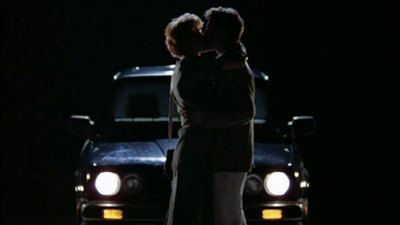
Jamie S. Rich is a novelist and comic book writer. He is best known for his collaborations with Joelle Jones, including the hardboiled crime comic book You Have Killed Me, the challenging romance 12 Reasons Why I Love Her, and the 2007 prose novel Have You Seen the Horizon Lately?, for which Jones did the cover. All three were published by Oni Press. His most recent projects include the futuristic romance A Boy and a Girl with Natalie Nourigat; Archer Coe and the Thousand Natural Shocks, a loopy crime tale drawn by Dan Christensen; and the horror miniseries Madame Frankenstein, a collaboration with Megan Levens. Follow Rich's blog at Confessions123.com.
|
| Popular Reviews |
| Sponsored Links |
|
|
| Sponsored Links |
|
|
| Release List | Reviews | Shop | Newsletter | Forum | DVD Giveaways | Blu-Ray | Advertise |
|
Copyright 2024 DVDTalk.com All Rights Reserved. Legal Info, Privacy Policy, Terms of Use,
Manage Preferences,
Your Privacy Choices | |||||||









